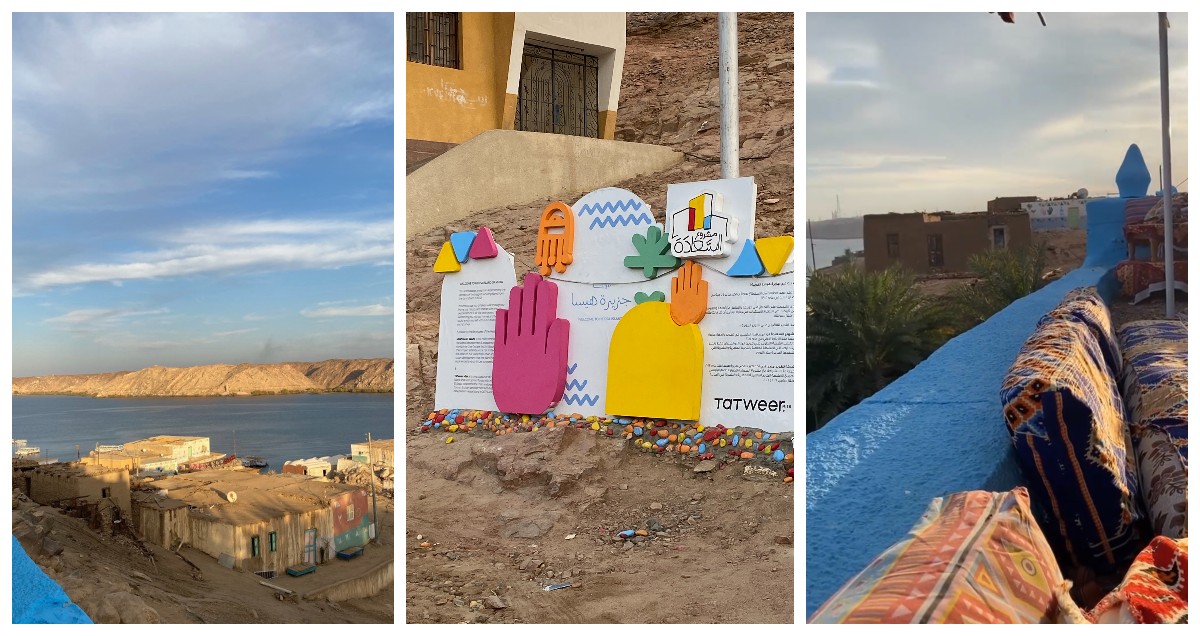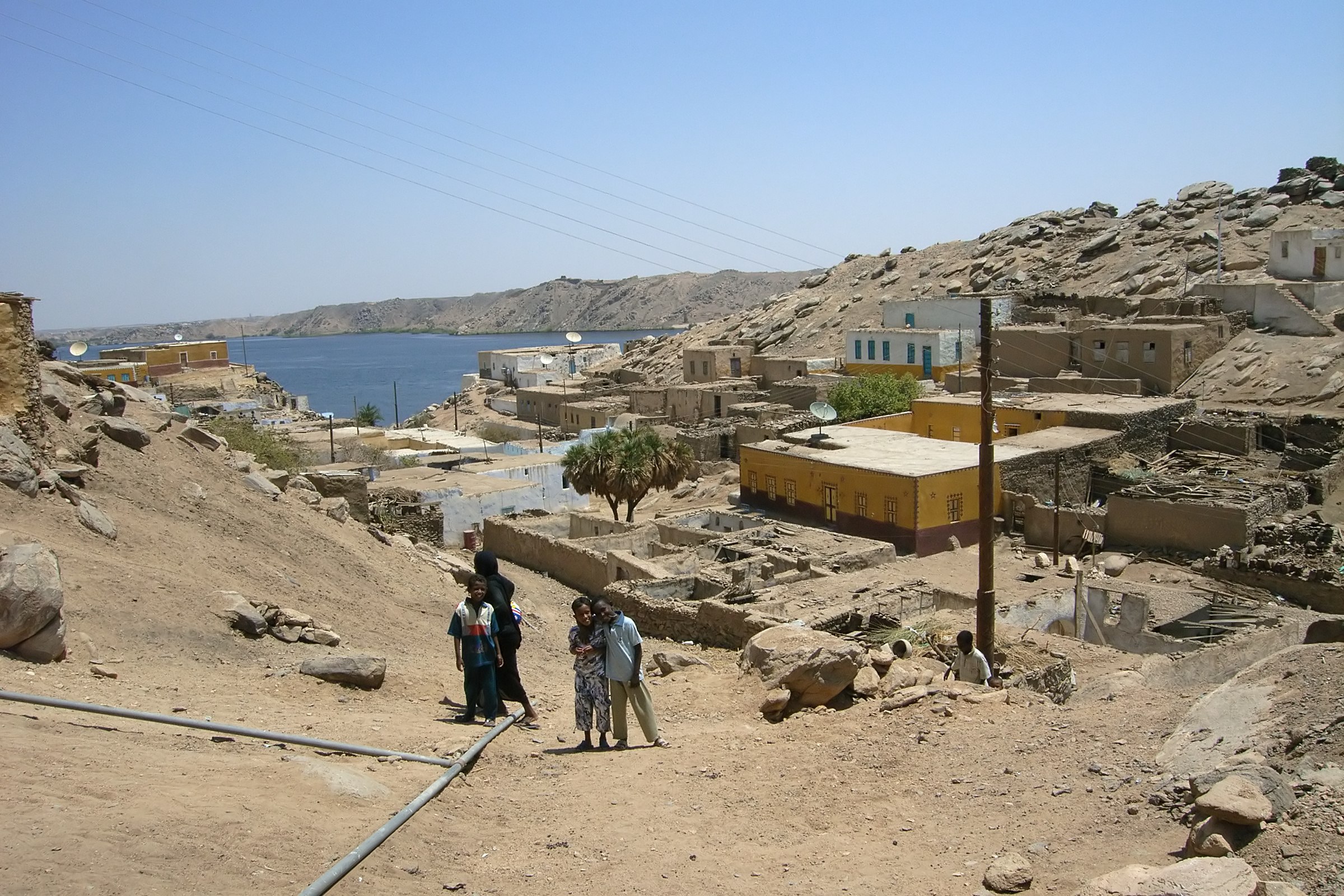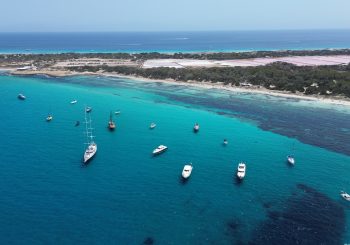“Two more meters, hanet (almost there)!” shouts the tour guide at us, a group of panting tourists climbing up the steep road to the top of “Heisa” island. We had just left Philae temple, the crown jewel of Aswan, which is adjacent to the small island.
Heisa is a small island located east of Aswan, squeezed between the Philae Temple and the Nile River Dam. It is one of the oldest standing Nubian islands and the only one that remains to this day. The town sits on high ground, making it an adventure for anyone who wants to visit.
Some are dizzy from the boat ride from the Aswan port; others are starving after a long day of exploring the city’s many temples and attractions.
The island doesn’t look like much when we arrive, all we could see is a steep hill with a completely empty road leading up. In the distance, we could see small figures but we weren’t able to make them out yet.
Exhausted yet curious, we push ourselves a little more in hopes of reaching the top of the dirt roads, marking the end goal of the trip: ‘Am Yasser‘s house. Awaiting at the top is a magnificent space filled with cushions and low tables, piled high with all the homemade Nubian dishes our hearts desire.
Keen to supplement his income, ‘Am Yasser is one of many homeowners who converted their living spaces to guest houses. Since the island’s deterioration over the last few years, due to lack of resources and natural causes, many tourists have shifted their attention to sparklier, better-funded attractions, leaving authentic ones, like Heisa, behind.
Surviving flooding and upheavals
Heisa’s first crisis manifested in 1902 when most of the farmland was flooded due to the building of a small dam.
Years later, when the Aswan reservoir and dam were built in the 1930s, many of the neighboring islands’ residents were displaced from their lands in fear of the upcoming floodings. The Heisa community was one of the few to not relocate, opting for higher ground instead.
The island however was still flooded, with it, most of their farmlands.
According to one local, until today, Heisa’s water supply is rationed, and the island didn’t have electricity up until the 1980s. Exacerbating certain woes, there is only one primary and middle school on the island, and children seeking higher education have to travel to nearby, larger villages on the mainland.
Moreover, Heisa only has one doctor, who migrated from Mansoura to work on the small island, when he’s on vacation, the sick have to travel to Aswan to seek treatment. With the island in dire need of various help, many projects were initiated, including the “Project Heisa” by CISV Egypt in 2017.
The three-week intensive volunteer project aimed to build a community center to keep the Nubian language and culture alive. Yet, it is clear that the precious island relies fundamentally on its visitors to keep it financially afloat.
A socioeconomic glimmer of hope: tourism
The town was simply desolate, with the highlight being ‘Am Yasser’s house, and one or two other guest houses.
As we climb the mountain, we start meeting locals, little girls, and women selling lavender flowers. They have them laid down in front of them on the floor, on tiny handmade carpets, intricately woven with beautiful designs.
The little girls smile and wave at us; they do not run and shove products in our faces, as is known to happen in many other places famed for harassment of visitors. Some of us do stop and buy their products, others exchange greetings, and keep going. The girls smile, and say “khamsa geneh” (EGP 5, USD 0.3), pointing at the beautiful flowers.
Beyond the little girls, the town is barren, quiet. The colorful houses sat empty, not a single noise to be heard. It was almost sunset, we just assumed people had gone home to a quiet night in.
When we reach the top, we are delighted by the spread of rice, pasta, duck, and pigeon meat. Beyond the spread of mouth-watering dishes is an immaculate view of the Nile River, the walls of the Aswan Dam, and the Philae temple.
“Ahlan wa sahlan, hamdella ‘ala salametko!” (Hello, welcome), greets ‘Am Yasser, a tall, middle-aged man with the warmest smile. He laughs at our exhausted faces and out-of-breath demeanor.

In terms of its story, despite not being very well-known, the island is named after the king, “Hess,” of the seventh dynasty of ancient Egypt. In the past, Heisa was a burial ground for priests who worked on the island as well as Philae island.
It was also a natural supplier of wood and stones, the same stones that were then transported across the Nile to, later on, become the Saqqara pyramid.
When walking into Heisa, one’s mood will quickly change due to the bright, vivid colors decorating all of the houses. It is where simple art and architecture beautifully combine to form a masterpiece.
Moreover, going up, the air smells different, cleaner, undisturbed by the bustle and noise of modern civilization. Life is simple in the eyes of the visitor of Heisa: one eats, sleeps, and lives in nature. In the morning, the view distracts the island’s visitors from the routine of everyday life, and at night, the stars dazzle. Even the hotels are simple camps or lodges, focusing on providing a view of crystal clear skies and beautiful water.

Soon, night falls on us. We all look up, and the stars seem to be close. This is when the second course comes in: Zalabya – a dessert made up of fried dough with toppings – is served with tea. The piping hot dessert, just out of the bubbling oil, is buried under a mountain of powdered sugar. The Nubian tea, brewed in the heat of embers, soothes our bodies now that the sun is no longer there to keep away the cold night air.
We watch the stars as the lights are dimmed to make them even clearer. We dread the journey down the steep hill, and the boat rides back to their hotels. We never want to leave.
‘Am Yasser charges us EGP4000 (USD 250) for nine people, which includes a visit to a neighboring riverbank, where we kayaked and drank Nubian coffee. This price is worth the delightful accommodation and view.
Satiated, as we prepare to depart, ‘Am Yasser leaves us with another warm smile and more food we can heat up and enjoy when we are back at home.
We make our way down the mountain, laughing at our lazy steps due to our very full bellies. We vow to come back again, already missing the island as we get on the boat.






Comments (5)
[…] قصة هيسا ، الجزيرة النوبية الأخيرة […]
[…] قصة هيسا ، الجزيرة النوبية الأخيرة […]